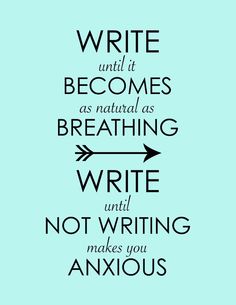
Being a teacher, I am accustomed to acronyms: Did you complete your PDP? This year we are working on PLNs. Are you attending the SST meeting? The new standards are about the four C‘s……I am also used to every expert’s different take on writing: Think Sheets, Power Writing, Brainstorming, Spider Webs, Slug Notes.…..so I thought about writing and what its important elements might be, and I came up with TOMAS, which I presented at one of the corporate writing workshops I conducted.
A good piece of writing should encompass these five things: TOMAS (Pronounced Toe-Maas, with the accent on the second syllable)
T= thought. You cannot write unless you put some thought behind your writing. You need to have something to say, or why write? Outlines, brainstorms, lists, notes, spider web drawings . . . all these things can help you get your thoughts down.
O= organization. An unorganized piece of writing is a mess and difficult to read and to understand. The information is of little use if it is presented in a disorganized fashion. Writing needs a beginning, a middle, and an end. Writing of more than 5 or 10 sentences needs to be divided into paragraphs. Paragraphs should stick to one topic, generally introduced in the first sentence of the paragraph. Information within one paragraph shouldn’t go from subject to subject. There should be an introduction and conclusion to your writing, whether it is a sentence (in a shorter or one-paragraph piece), or introductory and concluding paragraphs in a longer piece. Outlines and first drafts are good for organizing.
M=mechanics. Ah, here is my favorite! By mechanics we mean the grammar, punctuation, capitalization, and spelling that make our writing consistent, and easy to read and understand. These components are a “given” for good writing. Besides sounding and looking better, writing with good mechanics is just plain easier to read.
A= audience. This is a surprisingly important component to writing and one that is often overlooked. When my students write an essay, I am the audience. I don’t want to read slang, language shortcuts (gonna, 2 for the word too, cool), and writing more suitable for a text message to a friend. Yes, this language is fine for a text message to a friend, but it won’t do in a college application essay or a cover letter. It is important to keep your audience in mind. You don’t want to use company or occupation-specific jargon if you are writing to people unfamiliar with the company or the profession. The general audience will not understand complex legal or medical terms, for example. Also keep in mind the education level of your audience when choosing words. If you are writing to an all-female audience, don’t use he as the gender-neutral pronoun! And don’t talk down to your audience! We generally don’t like being written to as if we were children.
S=style. Organization, mechanics, and writing to the appropriate audience can be taught. Gathering your thoughts before you write can also be taught to a point (we can’t so easily be taught how to think). But style—that one isn’t easy to teach and may not even be possible to teach. Each of us has his or her own writing style. Some people just seem to have a talent for writing. Others find writing more difficult, and their writing is more of a chore. Is it possible to develop style? Probably. Of course style in creative writing (fiction, and creative nonfiction like some memoir) is a little different than style in writing letters or white papers. However letters, blog posts, white papers, and articles certainly have style too. Reading a great deal in one’s writing genre probably helps fiction writers (which is not my speciality right now, so I can only guess) develop their style, as well as just writing, writing, writing . . . .
So next time you sit down to write anything, think about TOMAS: Thought, Organization, Mechanics, Audience, and Style. Happy Writing!



Great title, Arlene! I think I will start using that line as we begin class! I work with elementary ESL students who are basically fluent speakers. I always tell them to write how they speak, since most of the time our elementary students don’t test out of ESL due to the writing factor. This encourages me to help them push through until they are comfortable writing. And – STYLE – a great word for us to reflect on as we teach writing. Thanks for the tips!
I am so glad you like them and can use them!
Thanks for the interesting post, Arlene.
In the past we used to call it “creative writing”. Maybe I’m from the old stock, but I seem to miss the encouragement of creativity in writing. I agree with you that “thought” is the first step in the writing process but what type of thought? Is it just a matter of retelling about “My Vacation” if it were the topic or do I try and write it in such a manner that it grabs the reader’s attention ? Isn’t my writing a success if it were interesting and convincing?
The WIDA rubric that we use concentrates on: linguistic complexity, vocabulary usage, language control and text structure. Does this rubric encourage a student to be creative? I don’t think so. I tend to think that the emphasis is mainly on correctness and creative thinking is falling by the wayside.
Help me if I’m missing the point.
You certainly make a valid point! I have a few comments:
1. I am mostly — at least right now — a nonfiction writer from a nonfiction background, and also a teacher and grammarian, so I tend to think only in terms of more formal business writing.
2. I have been in the school environment for a while, while by junior high the new standards want nonfiction writing and don’t really preach creativity. In elementary school, there seems to be more of a focus on creativity.
3. Creativity might fall under my S for style. Most students do OK with the creativity part, but they cannot put a sentence together correctly. They also are often disorganized and write for an incorrect audience. I think you need the basics before you can add a creative style — at least unless you have a really good editor!
Thanks for the comments!!
Thanks for this concise overview, Arlene. A couple of additional tips:
* Organizing may start with outlines, but much of the work is done in revision. As writers read their work, they can spot–and hopefully fix–organization problems. If this is true, then some of the pressure of organizing can be removed during the initial drafting work.
* Style–for me–is connected to speaking. I often talk aloud or at least move my lips when I’m writing. The way I talk informs the way I write. I believe this is true for many writers. While some folks claim that speech and writing are very different activities, I’m in the camp that sees writing as “writing down speech”–with the writer being a kind of secretary, taking dictation. Some great literature–including perhaps the Bible, Aristotle, Aesop’s Fables, Homer–was originally oral.
Thanks for the great comments and helpful additions to the post! Good points all, Murray.
Great post, Arlene!
Thank you, social media guru!
Thanks for the link!